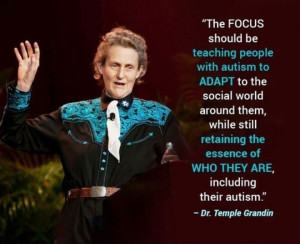
Teaching Non-Verbal Children On The Autism Spectrum
Teaching Non-Verbal Children On The Autism Spectrum
“It is the supreme art of the teacher to awaken joy in creative expression and knowledge”
-Albert Einstein
Teaching Non-Verbal Children, The following article is authored by Ms. Alakananda Sen, who is now the Managing Director and Principal of Viha Primary School in Bangalore, India. In this article, she questions the common myths surrounding nonverbal children and also offers strategies to test and apply differentiated teaching methods for nonverbal children on the Autism Spectrum. Nonverbal does not imply incapable!
I am not a trained special educator, but a teacher who is passionate about making the teaching-learning process a wonderful journey. The reason I am beginning with this preamble is that I am no authority on the methods and practices that are to be used for non-verbal children, but rather, I am presenting a storyboard of events that when followed, can create a beautiful learning story with these children.
Non-Verbal Children for Autism
When one hears and reads about Autism and its related difficulties, one is instantly worried about the case of non-verbal children. Here is a group of children who are widely misunderstood owing to their mannerisms. There are beyond ‘normal’ sounds, gesticulations, actions and habits that when the untrained eye encounters, the image formed is one of a child with severe handicaps, especially in the domain of intelligence and comprehension.
These children will never see a regular classroom for the very reasons and will never be treated with the respect they deserve purely owing to the lack of understanding on the parts of several people, most of them, sadly, being adults.
This is my story; this is the tiny dent that I would like to create in this unkind and unfair image that exists, so do give me a patient ear for a while. In my years of work with non-verbal autistic children, there were some cardinal truths to be dealt with.
Firstly:
These children may have the attention span of a toddler (however old they may be), so when one starts work with them, the assumption is that they haven’t noticed anything that was taught. Correct?
Wrong, they do!
And they do so much better than an average child of that age. The difference lies in how quickly they are able to look at and scan a demonstration, instruction, or document. Once that is out of the way, these children are waiting for our next step forward, which many of us omit, and tend to repeat till the child is bored stiff and does exactly what we expect him/her to do…throw a fit, scream, throw things around, or slide off the chair into the welcoming oblivion that the space below the table offers.
It is unfortunate that, this is when we consolidate our claim of non-verbal children having acute behavioural issues. I am not saying that some don’t, but at most times, it is because we the ‘adults’, the ‘be all and know-alls ’ in the picture haven’t understood that they could have achieved the first objective of listening/reading/understanding with greater ease than we had imagined.
Secondly:
The level of comprehension and extent of a skill learnt by non-verbal children can only be deciphered when one has tried various methods to gauge that level. One cannot assume that the comprehension or skill set would be proportional to their extent of social and physical difficulties, or be commensurate with the standard objectives to be met for a certain grade or age.
It is best to start with the basics and move up the rung sequentially, assessing at each stage, what works for the student and the extent to which the skills have been mastered, sans any assumptions or bias. Teaching Non-Verbal Children
Choosing the very basic lower order skills of recall, and comprehension only is detrimental to the child’s ability to respond to challenges and only serves to severely hamper the child’s ability to enjoy a task. Teaching Non-Verbal Children
The principles of Bloom’s Taxonomy to teach and create assessment methods, help me create lesson plans that have ‘character’. A lesson plan has ‘character’ or ‘depth’ when it takes into account what the child already knows ( I would have tested at each level and gauged that), what the child has mastered and how we as teachers can raise the bar, so that the child finds meaning and reason in working hard.
I don’t adhere to the idea that a child must only learn what has been assigned to a grade; there may be a number of skills that may have been overlooked if one followed only this and the unfortunate fall out, is a bored and destructive child.
Thirdly:
The amount of positive change and good work that a non-verbal child can do is directly proportional to the effort, patience and unconditional love a teacher can show to keep up and steer ahead. That is the least one can do when one has chosen to work with children with special needs. Any form of condescension and impatience pushes the child into a corner, the corner that becomes a safe place for him/her to not react or act anymore.
It is heartening to see several teachers’ use differentiated teaching methods in their classrooms, trying to figure out the multiple intelligences their students have, but while teaching special children all these wonderful principles seem to be shelved. We need to bring these to the fore.
As teachers who want to reach out to every child, including that non-verbal little soul in the class, we must employ techniques that ensure we have taken into consideration, how the child likes to learn.
Differentiated Teaching Strategies:
This isn’t difficult to do. I usually use a variety of simple techniques.
- I think demonstrations work well as teaching modules and try and ensure that every new topic I do, includes a fun demonstration.
- One that is animated somewhat exaggerated in terms of what one can achieve with that activity and how one can reach a solution.
- The drama and exaggeration help catch the attention of the otherwise distant and distracted learner and the demonstration of how a solution can be found has usually been accepted quite well by my non-verbal students.
- It’s best to keep instructions short and simple and provide a visual scaffold of how and what one expects as a result. Just one example helps set the flow.
- Some non-verbal children may also have poor muscle tone, so a pencil grip is tough and challenging. In such situations, I alter their activities to include multiple choices, so I can cut down their writing. This gets me a much faster response to the tasks. Sadly, writing, being the documented proof of what a child can do is often used as the only tool to get work done. A greater travesty I can’t imagine!
- A non-verbal child can think much faster than he/she can wield the pencil and that puts them in an awful state of frustration. We have no right to pile up hurdles this high for a child who is already dealing with so much.
- One should respect the child for his abilities and focus on helping him/her cope with their difficulties. Discussing their difficulties in their presence has to be avoided; they can’t speak, but they are not daft or deaf!
- Plans must be drawn up with clear insights from the parents and other teachers to get a 360 degree understanding of the strengths and difficulties, such that goals set are realistic and achievable and ones that help build the child’s skills and esteem.
I strongly believe that one’s self-esteem and self-image are a consequence of the love, attention and dedicated help one receives from one’s parents, families, friends and teachers. And since as teachers we share this one pillar of responsibility, it is imperative that we work our hardest at building the self-esteem of the non-verbal children in our care.
In conclusion, I would like to use a line from Rabindranath Tagore’s song ‘ Ekla cholo re’ which is a patriotic song, dating back to 1905 or so. Roughly translated, “Jodi tor daak shune keu na aashe tobe Ekla Cholo Re” means if no one responds to your call then walk on your path alone.
So dear parents, teachers and well wishers of non-verbal children, seek that path of helping children the right way yourselves, even if the system prevailing hinders that!
If this article has inspired you, share it to make it a better place for nonverbal children on the Autism Spectrum Conditions.
View this post on Instagram
- Nonverbal Autism - December 22, 2022
- Spectrum of Hope: The New Normal - April 29, 2018
- Preschool Children’s Speech and Language Development: 2 to 6 years - April 16, 2018


Leave a Comment
(2 Comments)
Great to see this from someone who understands non verbal kids better than anyone else !!
It’s great that it is coming from an educator! Children who are nonverbal are simply beyond verbal. We have to have differentiated teaching methods in the classroom. Ms. Alakananda Sen has shared very useful insights.
Categories
Recent Posts